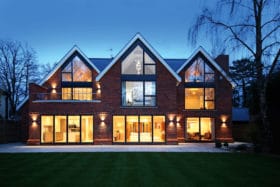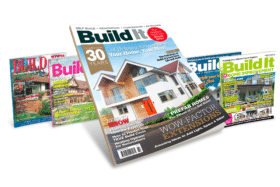
Early Bird Offer! Free tickets to meet independent experts at this summer's Build It Live
Save £24 - Book Now!
Early Bird Offer! Free tickets to meet independent experts at this summer's Build It Live
Save £24 - Book Now!Oak framing provides many positive ecological benefits across several platforms. While the trees grow they take carbon out of the atmosphere and hold it in the wood. When you make it into a house, that carbon is locked away for the lifetime of the building.
At the end of that building’s lifespan (which is likely to be centuries), oak frames can be reused and repurposed to construct something else. Oak only gets better and stronger with age. Oak is also unusual in that it doesn’t require any toxins to be preserved. Plus the process to turn a tree into a suitable building material only involves a couple of saws – it’s very low energy.
The wood we use is grown specifically for the purpose of construction. Oak takes about 60-100 years to mature enough before it can be used in a building. In that growing time, you maintain a really stable biodiverse eco-system – each tree can sustain over 200 different organisms. You must be careful to not fell a whole forest in one go!
A responsible oak farm would take trees out of the farm gradually, throughout different phases of growth, based on what you need the material for and to support sustainable forestry management. So, it creates a nice circle of sustainability – even though you’re cultivating this crop to eventually cut it down, while it’s growing the forest makes a long-term environment for other eco-systems to prosper.
Border Oak only purchase FSC and PEFC certified timber. It’s a scrutiny-based system with lots of regulations suppliers need to adhere to. We buy from farms with replanting schemes that are audited in order to ensure it is sustainable and ethical.
Plus, it’s in a farm’s best interest to produce this way because they want to sell their product again and again. Oak needs to be grown in competition with other mature trees in order to be straight, so, from a commercial perspective, it’s vital there is a replanting plan and they don’t cut huge sections.
As a product, oak has a significantly low carbon footprint, no matter where it comes from because it requires so little processing. Most construction grade oak is grown in the UK and France. Careful procurement processes mean we make best use of transport to minimise delivery mileage – ordering oak for several houses at a time when we can. We also don’t use automated machinery to make the frames – all of our oak is carved in the traditional manner, by hand.
There’s very little waste in our workshop. By properly and fully designing the house to start with and using thorough quantity surveying systems we only order the materials needed. This dramatically alters how much waste you will have but also ensures we are cost efficient.
The offcuts from the workshop are used in a woodburner to heat the office (which doesn’t have central heating). Other local businesses collect and dry larger amounts to later sell on as firewood.
In the yard, we have a separate pile of the oak that hasn’t met our grading standards for various reasons. If this isn’t collected we try and use it for local charity projects and community schemes.
I think if someone is really interested in sustainable living, they’d want to know a bit about their materials – for instance, how the oak is grown and what certification is in place.
We try to do the legwork for our clients to maintain our own rigorous standards and are always striving to improve. For example, we have a policy of specifying local manufacturers and suppliers wherever possible, to reduce transport miles, support local business and reduce the carbon footprint.
But the very best way to build sustainably is to ensure that the house doesn’t need much energy to run once it’s constructed – make it as thermally efficient as possible. We put a lot of focus into the fabric of the building, additional insulation and design around passive solar gain principles.
We offer a wide variety of construction packages too – for example, encapsulating an oak frame using structural insulated panels (SIPs) will deliver high thermal performance and airtightness.
It’s important to look at the right materials and products at the design stage. Communicate with your designer about what is important to you, whether it’s budget, sustainability, renewable tech or ethical purchasing. A good designer will tailor the scheme to your preferences.
For more information visit Border Oak

